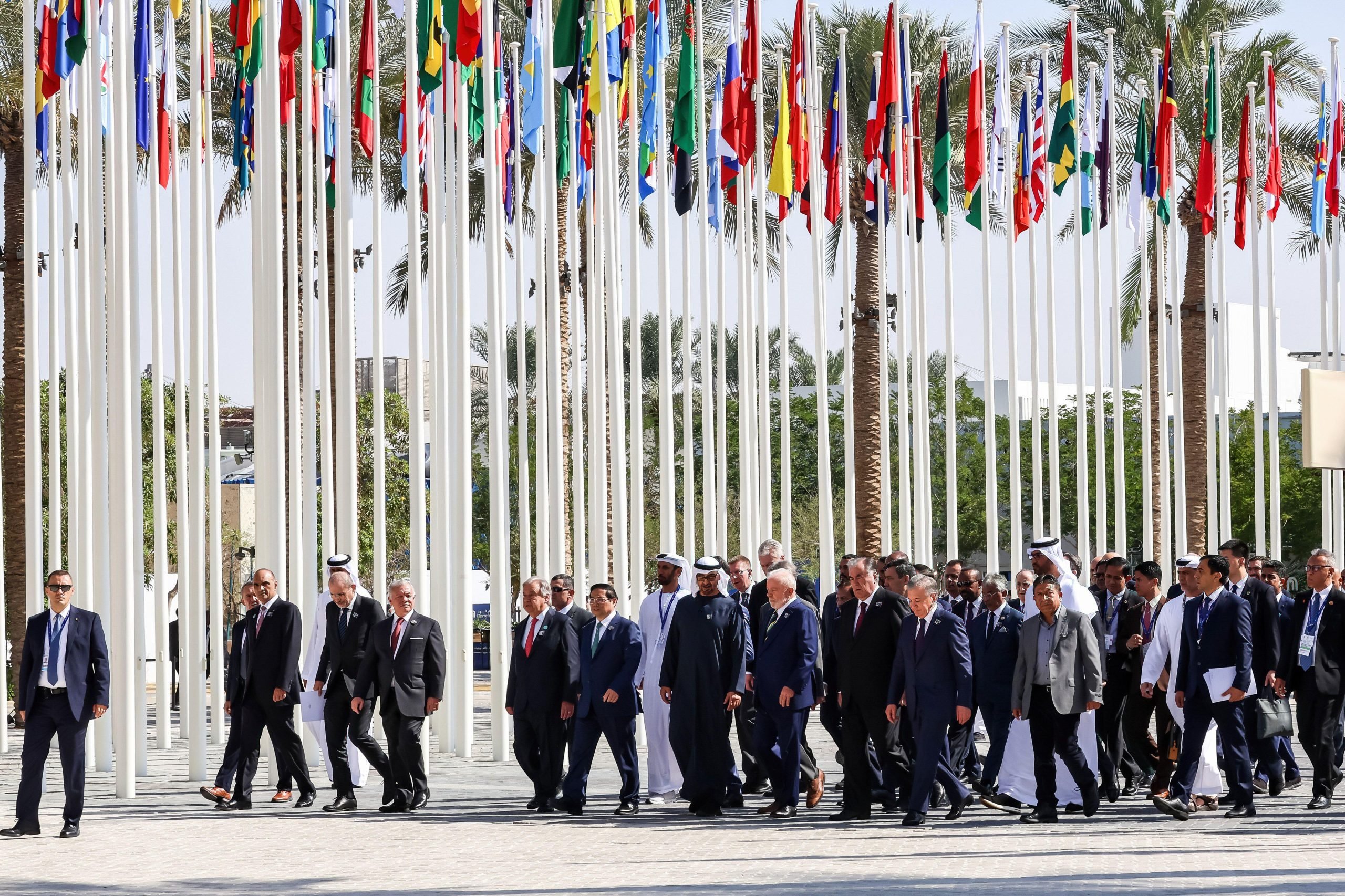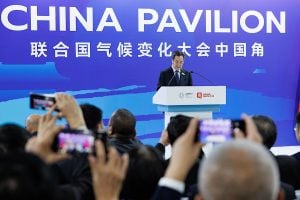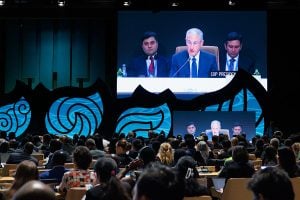As the 29th UN climate conference opens in Baku, Azerbaijan today, one thing remains the same: men will occupy most seats at the climate talks. Much has changed since the UN’s first Conference of the Parties (COP) to the Framework Convention on Climate Change in 1995. But the proportion of women representatives has remained stalled, at about a third of participants.
According to data from the Women’s Environment and Development Organization, women represented only 34% of party delegates and 19% of heads of delegation at COP28 last year. In comparison, 16 years ago at COP14, women comprised 31% of party delegates. This minimal progress is despite increasing calls for gender mainstreaming in climate action.
Why are women delegates missing at COPs?
In January this year, the organising committee for COP29 appointed 28 men and no women. After facing significant criticism, 12 women were added (and one more man). She Changes Climate, an organisation founded in 2020 that advocates for equal gender representation at climate negotiations, called the initial decision “a regressive step”. It asked for equal representation in the committee: “Climate change affects the whole world, not half of it.”
Afia Salam, a journalist and media development specialist focusing on climate change, environment and gender-sensitive reporting, tells Dialogue Earth that ensuring the voices of women are included often requires drastic measures, such as “gatecrashing committee meetings” in Pakistan. “It is a man’s world,” says Salam. “You see far more men than women in international climate negotiations. This has a lot to do with the historical baggage, where women are often missing from places of prominence and decision-making [in the countries that representatives come from].”
This global gender imbalance in leadership translates directly to climate negotiations, where national representatives mirror the gender disparities of their governments. In South Asia, only 16.6% of parliamentarians are women. Globally, only 23.3% of cabinet ministers are women. Worse, the portfolios they manage are often limited to gender, family and children affairs, social inclusion and development, as well as Indigenous and minority affairs. As important as these portfolios are, they do not set the agenda in the way that finance and energy do.
One barrier is social constraints related to gendered roles and responsibilities. Bharati Chaturvedi, founder and director of Chintan Environmental Research and Action Group in New Delhi, explains: “Women are not a homogenous lot [and] different women have different circumstances and contexts; work responsibilities; domestic responsibilities.” She adds: “Negotiators may not necessarily be women from prestigious government services and therefore they might be required to put in several nights preparing and being away for a fortnight, which takes them away from domestic responsibilities for several weeks.”
What can women bring to the climate discourse?
In the South Asian context, women are central to domestic and caregiving responsibilities, while also playing a crucial role in agriculture. They make up 43% of the agricultural workforce in developing countries, a sector that contributes 18% to South Asia’s GDP. Due to gender inequalities in the political, social and economic realms, women face higher risks from the impacts of climate change. This strengthens the case for their inclusion in climate action.
Salam highlights pervasive gender blindness in climate change policies and adaptation measures. “During disasters, something as basic as putting a relief kit together does not take into account the needs of the women; this nuance is being brought by women.” Salam says they “typically fail to include basic hygiene essentials, such as sanitary napkins, underwear, cloth towels, cotton pads, soap, along with special nutrition and dignity kits for pregnant and new mothers. In the absence of inclusive relief kits, people have stepped in to fill that gap.”
Salam notes that having more women involved in climate discussions would lead to a more inclusive approach for other marginalised groups: “Since they have been at the centre of caregiving, they are also thinking about children and elders. When women craft solutions, they are more likely to be inclusive.”
When women participate in climate change negotiations, it can potentially provide them access to technical spaces where key decisions on issues like mitigation strategies, adaptation measures and the financing of initiatives are made. This would allow them to play an important diplomatic role in decision-making, says Chaturvedi.
Among top examples of women negotiators influencing international climate talks is Sherry Rehman, the former climate minister of Pakistan. As the G77 chair at COP27 in Sharm El-Sheikh, she led the negotiations on loss and damage for the G77, where a commitment to set up a dedicated Loss and Damage Fund was made. Meanwhile, Sunita Narain, an environmental policy researcher from India, served on COP28 President Sultan Al Jaber’s advisory panel. As director general of the Centre for Science and Environment in Delhi, Narain is a prominent advocate for recognising historical responsibility when considering greenhouse gas emissions.
Not everything lies in the numbers
The mere presence of women in climate negotiations does not guarantee influence or systemic change, however. Chaturvedi is cautious about assuming that more women at COPs would create significant impact, as strategic decision-making often happens centrally, within ministries. “A better outcome is that gender interests are incorporated into negotiations,” she says.
Salam agrees, and suggests the power and clout women hold at the table are more important than the numbers alone. “We have had powerful women with strong leadership capabilities in the past, but these were only exceptions, not the norm.”
Broader issues lie in the nature of COPs themselves. Many question the efficacy of COPs in driving meaningful climate action, especially when civil society groups face restrictions. Chaturvedi notes: “When you shut down protests, you are also shutting down a lot of women’s voices, because there are a lot of women in the justice conversation.”
Key to women’s solidarity is South Asian cooperation
Political crises compound the climate crisis in the absence of regional cooperation. Salam highlights the urgent need for cross-border cooperation between India and Pakistan: “We are independent countries, but we have shared problems. We have transboundary rivers and hence we share similar water problems. Delhi and Lahore share the same air pollution issues.”
While such collaboration is challenging due to complex intergovernmental relationships, Chaturvedi argues that more investment in female solidarity- and confidence-building is essential. “The power of civil society is rooted in solidarity, and this solidarity would come from panels and conversations.”
There are small glimmers of hope, though. Last year, the COP28 presidency urged parties to bring gender-balanced delegations. Parties also agreed that the final review of the implementation of the enhanced Lima Work Programme on Gender (LWPG) will be concluded this month. Established in 2014 at COP20 in Peru, the LWPG aims to advance gender balance and ensure women’s equal and meaningful participation.
Through an open letter, the Women and Gender Constituency has urged negotiators at COP29 to include gender-responsive measures in climate policies and address the barriers preventing women’s full participation in climate negotiations. Time will tell if gender equality truly gains ground in climate change decision-making.









